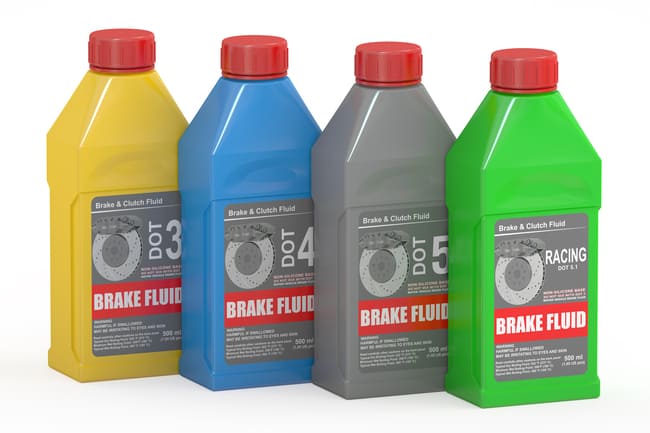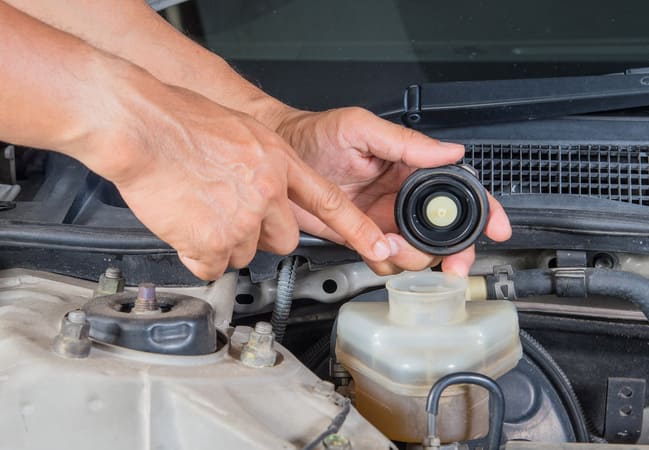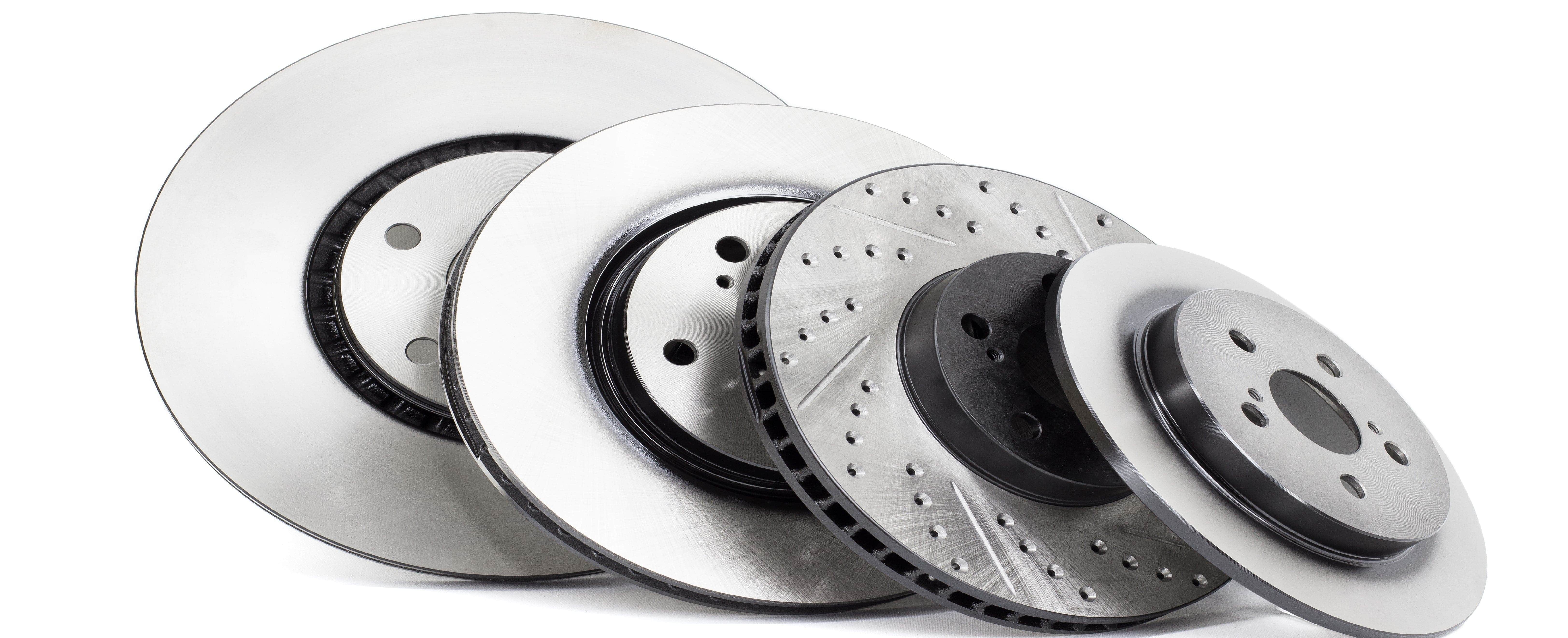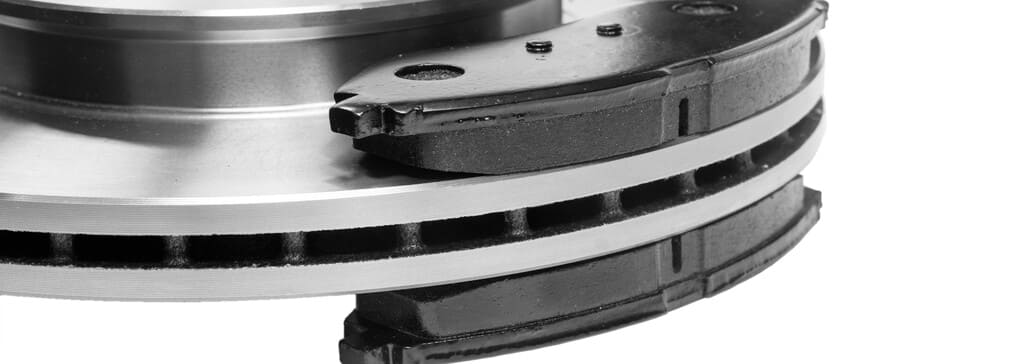
Brake fluids DOT 3 and DOT 4 – what's the difference?
DOT 3 and DOT 4 are brake fluid specifications set by the Department of Transportation (DOT) in the United States. While both are used in automotive braking systems, DOT 3 and DOT 4 brake fluid for your car do differ. Let's look at them in more detail.

Composition
Both are glycol-based. They contain a mixture of glycols, such as ethylene glycol or diethylene glycol, together with various additives to improve performance and protect against corrosion. However, DOT 4 fluids often have a larger concentration of glycols and different additive packages when compared to DOT 3 fluids.
Boiling points
One of the main differences between these types is their boiling points. DOT 4 fluids typically have a higher boiling point compared to DOT 3. The minimum dry boiling point for DOT 3 is 205°C (401°F), while for DOT 4 fluid it is 230°C (446°F). The wet boiling point, which refers to the boiling point when the fluid contains a certain amount of moisture, is also higher for DOT 4 compared to DOT 3 fluid.
Mixing
Car owners often ask if DOT 3 and DOT 4 brake fluid for BMW can be mixed together without any problems. The answer is yes. This is due to the fact that both are composed of glycols. However, it is essential to note that this will affect the overall boiling point. The two brake fluids can be used interchangeably. If you have a vehicle originally fitted with DOT 4, we advise against using DOT 3 fluid as a top-up. Conversely, vehicles designed for DOT 3 fluid can use DOT 4 without difficulty.

Fluid change interval
Both DOT 3 and DOT 4 require periodic replacement. The recommended fluid change interval may differ depending on the manufacturer's specifications and driving conditions. In general, DOT 4 tends to have a longer service life than DOT 3.
Fluid change maintenance intervals
Brake fluid should be replaced regularly to maintain its effectiveness. The recommended replacement interval varies depending on the type of brake fluid and the vehicle manufacturer's specifications. It is generally recommended that the brake fluid be changed every 1-2 years or as specified in the vehicle's service schedule. This is normally carried out by automotive professionals during routine car brake parts inspections or brake fluid flushes. These procedures involve draining and replacing the brake fluid to maintain its integrity and performance.
TOP products on the subject:
Top products at reduced prices
-
- Quality: TYP 200
- Capacity [litre]: 1
- DOT specification: DOT 4
- Packing Type: Can
- MAPP code available
- Condition: New
DetailsArticle № : 03.9901-6202.2 Brake Fluid 03.9901-6202.2
 Car parts maker: ATEMore1L(12)
Car parts maker: ATEMore1L(12)In stock
£ 17,48£ 17,48 for 1 litreincl. 20% VAT -
- Quality: SL.6 DOT 4
- Capacity [litre]: 1
- DOT specification: DOT 4
- Packing Type: Can
- MAPP code available
- Condition: New
DetailsArticle № : 03.9901-6402.2 Brake Fluid 03.9901-6402.2
 Car parts maker: ATEMore1L(2)
Car parts maker: ATEMore1L(2)In stock
£ 11,71£ 11,71 for 1 litreincl. 20% VAT -
- Product line: Prime
- Quality: DOT 4 Low Fan clutch
- Capacity [litre]: 1
- DOT specification: DOT 4
- for article number: L 04 210
- Packing Type: Bottle
- Dry Boiling Point [°C]: 260
- Wet Boiling Point [°C]: 170
- Condition: New
DetailsArticle № : L 04 210 Brake Fluid L 04 210 Car parts maker: BREMBOMore1L(2)
Car parts maker: BREMBOMore1L(2)In stock
£ 9,28£ 9,28 for 1 litreincl. 20% VAT -
- Product line: DOT-4 BRAKE FLUID
- Capacity [ml]: 455
- Specification: SAE J1703, SAE J1704, ISO 4925, JIS K 2233
- Packing Type: Bottle
- Manufacturer recommendations: FMVSS 116 DOT 4
- Dry Boiling Point [°C]: >245
- Chemical Properties: Synthetic
- Colour: brown/transparent
- Condition: New
DetailsArticle № : MN3002-05 Brake Fluid MN3002-05 Car parts maker: MANNOLMore0.455L(9)
Car parts maker: MANNOLMore0.455L(9)In stock
£ 5,28£ 11,60 for 1 litreincl. 20% VAT -
- Product line: DOT-4 BRAKE FLUID
- Specification: SAE J1703, SAE J1704, ISO 4925, JIS K 2233
- Capacity [litre]: 1
- Packing Type: Bottle
- Manufacturer recommendations: FMVSS 116 DOT 4
- Dry Boiling Point [°C]: >245
- Colour: brown/transparent
- Chemical Properties: Synthetic
- Condition: New
DetailsArticle № : MN3002-1 Brake Fluid MN3002-1 Car parts maker: MANNOLMore1L(24)
Car parts maker: MANNOLMore1L(24)In stock
£ 5,68£ 5,68 for 1 litreincl. 20% VAT -
- Product line: Prime
- Quality: DOT 4
- Capacity [litre]: 1
- DOT specification: DOT 4
- for article number: L 04 010
- Packing Type: Bottle
- Dry Boiling Point [°C]: 260
- Wet Boiling Point [°C]: 165
- Condition: New
DetailsArticle № : L 04 010 Brake Fluid L 04 010 Car parts maker: BREMBOMore1L(2)
Car parts maker: BREMBOMore1L(2)In stock
£ 8,42£ 8,42 for 1 litreincl. 20% VAT -
- Capacity [ml]: 500
- Specification: FMVSS 116 DOT 4
- Capacity [litre]: 0,5
- DOT specification: DOT 4
- Packing Type: Tin
- Condition: New
DetailsArticle № : 109452 Brake Fluid 109452 Car parts maker: MOTULMore0.5L(1)
Car parts maker: MOTULMore0.5L(1)In stock
£ 17,33£ 34,66 for 1 litreincl. 20% VAT -
- Quality: SL DOT 4
- Capacity [litre]: 1
- DOT specification: DOT 4
- Packing Type: Can
- MAPP code available
- Condition: New
DetailsArticle № : 03.9901-5802.2 Brake Fluid 03.9901-5802.2
 Car parts maker: ATEMore1L(74)
Car parts maker: ATEMore1L(74)In stock
£ 14,68£ 14,68 for 1 litreincl. 20% VAT -
- Capacity [litre]: 0,5
- DOT specification: DOT 3, DOT 4
- Oil: Full Synthetic Oil
- Manufacturer recommendations: FMVSS 116, DOT 4, DOT 3, SAE J 1703, ISO 4925 (3 et 4)
- Observe service information
- Condition: New
DetailsArticle № : 102718 Brake Fluid 102718 Car parts maker: MOTULMore0.5L(3)
Car parts maker: MOTULMore0.5L(3)In stock
£ 6,48£ 12,96 for 1 litreincl. 20% VAT -
- Specification: JASO JIS K2234
- Capacity [litre]: 1
- DOT specification: DOT 4
- Packing Type: Tin
- Manufacturer recommendations: ASTM D3306(I), ASTMD4985, ASTMD6210, BS6580:2010, Ford WSS-M97B44-D, MAN 324 Typ SNF, MB 325.3, VW-TL-774F (G12+)
- Condition: New
DetailsArticle № : 15036B Brake Fluid 15036B
 Car parts maker: CASTROLMore1L(26)
Car parts maker: CASTROLMore1L(26)In stock
£ 12,18£ 12,18 for 1 litreincl. 20% VAT -
- Product line: Prime
- Quality: DOT 5.1
- Capacity [litre]: 0,5
- DOT specification: DOT 5.1
- for article number: L 05 005
- Packing Type: Bottle
- Dry Boiling Point [°C]: 260
- Wet Boiling Point [°C]: 180
- Condition: New
DetailsArticle № : L 05 005 Brake Fluid L 05 005 Car parts maker: BREMBOMore0.5L
Car parts maker: BREMBOMore0.5LIn stock
£ 5,58£ 11,16 for 1 litreincl. 20% VAT -
- Capacity [litre]: 0,25
- DOT specification: DOT 4
- Weight [g]: 256
- Weight [kg]: 1,18
- Condition: New
DetailsArticle № : 7522 Brake Fluid 7522
 Car parts maker: A.B.S.More0.25L(23)
Car parts maker: A.B.S.More0.25L(23)In stock
£ 4,18£ 16,72 for 1 litreincl. 20% VAT -
- Capacity [litre]: 5
- DOT specification: DOT 4
- Packing Type: Canister
- Dry Boiling Point [°C]: 260
- Wet Boiling Point [°C]: 170
- : 700
- Colour: yellow
- Length [mm]: 195
- Width [mm]: 165
- Height [mm]: 247
- Condition: New
MoreDetailsArticle № : 1 987 479 114 Brake Fluid 1 987 479 114
 Car parts maker: BOSCHMore5L
Car parts maker: BOSCHMore5LIn stock
£ 33,08£ 6,62 for 1 litreincl. 20% VAT -
- Capacity [litre]: 0,5
- DOT specification: DOT 4
- Oil: Full Synthetic Oil
- Manufacturer recommendations: FMVSS 116 DOT 4, SAE J1703
- Observe service information
- Condition: New
DetailsArticle № : 101666 Brake Fluid 101666 Car parts maker: MOTULMore0.5L(1)
Car parts maker: MOTULMore0.5L(1)In stock
£ 14,58£ 29,16 for 1 litreincl. 20% VAT -
- Product line: Prime
- Quality: DOT 4
- Capacity [litre]: 0,5
- DOT specification: DOT 4
- for article number: L 04 005
- Packing Type: Bottle
- Dry Boiling Point [°C]: 260
- Wet Boiling Point [°C]: 165
- Condition: New
DetailsArticle № : L 04 005 Brake Fluid L 04 005 Car parts maker: BREMBOMore0.5L(5)
Car parts maker: BREMBOMore0.5L(5)In stock
£ 5,60£ 11,20 for 1 litreincl. 20% VAT -
- Product line: Prime
- Quality: DOT 5.1
- Capacity [litre]: 1
- DOT specification: DOT 5.1
- for article number: L 05 010
- Packing Type: Bottle
- Dry Boiling Point [°C]: 260
- Wet Boiling Point [°C]: 180
- Condition: New
DetailsArticle № : L 05 010 Brake Fluid L 05 010 Car parts maker: BREMBOMore1L(2)
Car parts maker: BREMBOMore1L(2)In stock
£ 9,58£ 9,58 for 1 litreincl. 20% VAT -
- Product line: HIGH PERFORMANCE
- Capacity [litre]: 1
- DOT specification: DOT 4
- Packing Type: Bottle
- Condition: New
DetailsArticle № : 883461 Brake Fluid 883461
 Car parts maker: ValvolineMore1L(3)
Car parts maker: ValvolineMore1L(3)In stock
£ 11,58£ 11,58 for 1 litreincl. 20% VAT -
- Product line: DOT-4 BRAKE FLUID
- Specification: SAE J1703, SAE J1704, ISO 4925, JIS K 2233
- Capacity [litre]: 5
- DOT specification: DOT 4
- Packing Type: Canister
- Manufacturer recommendations: FMVSS 116 DOT 4
- Dry Boiling Point [°C]: >245
- Chemical Properties: Synthetic
- Colour: brown/transparent
- Condition: New
DetailsArticle № : MN3002-5 Brake Fluid MN3002-5 Car parts maker: MANNOLMore5L(1)
Car parts maker: MANNOLMore5L(1)In stock
£ 24,48£ 4,90 for 1 litreincl. 20% VAT -
- Specification: DOT 4 Plus
- Capacity [litre]: 1
- DOT specification: DOT 4
- Weight [kg]: 1,139
- Observe service information
- Required quantity: 1
- Condition: New
DetailsArticle № : 23930 Brake Fluid 23930
 Car parts maker: FEBI BILSTEINMore1L(3)
Car parts maker: FEBI BILSTEINMore1L(3)In stock
£ 10,99£ 10,99 for 1 litreincl. 20% VAT -
- Product line: Prime
- Quality: DOT 5.1
- Capacity [litre]: 5
- DOT specification: DOT 5.1
- Weight [kg]: 5,35
- Packing Type: Tank
- Condition: New
DetailsArticle № : L 05 050 Brake Fluid L 05 050
 Car parts maker: BREMBOMore5L
Car parts maker: BREMBOMore5LIn stock
£ 44,58£ 8,92 for 1 litreincl. 20% VAT

















